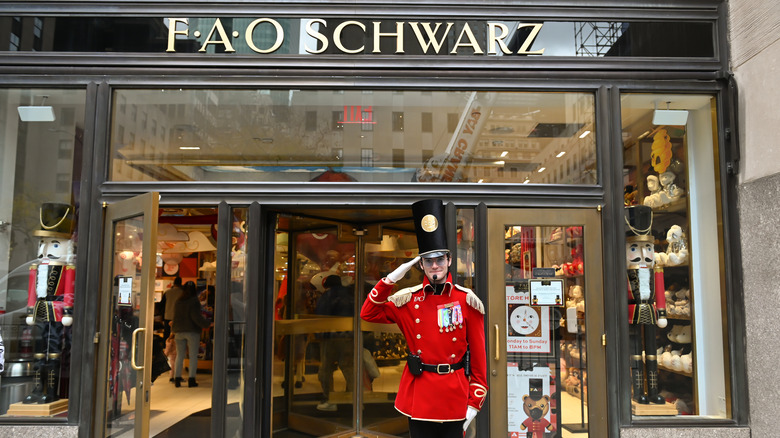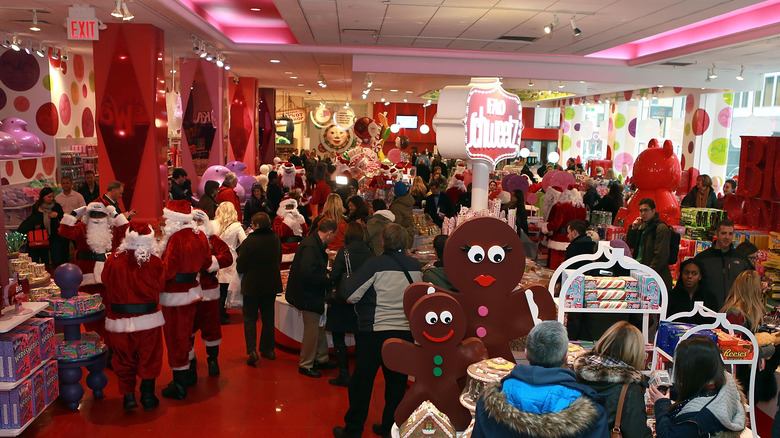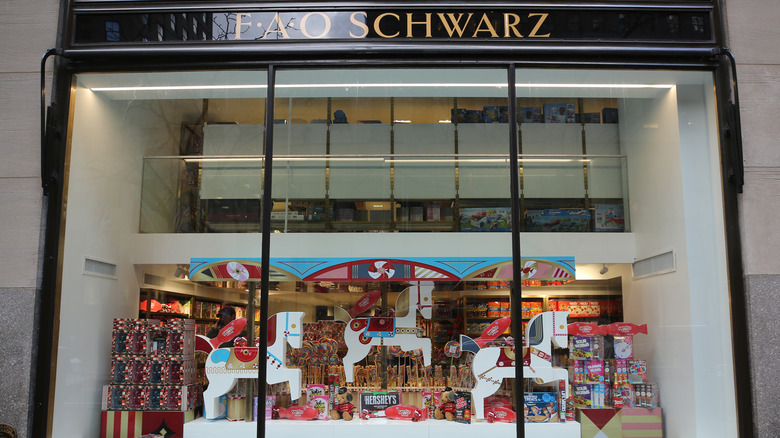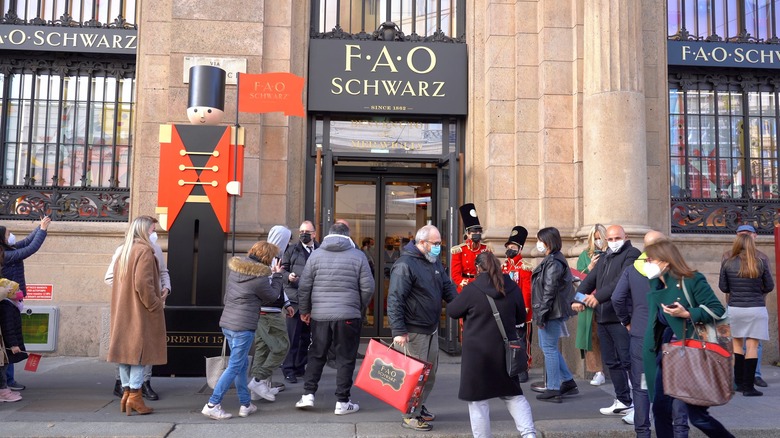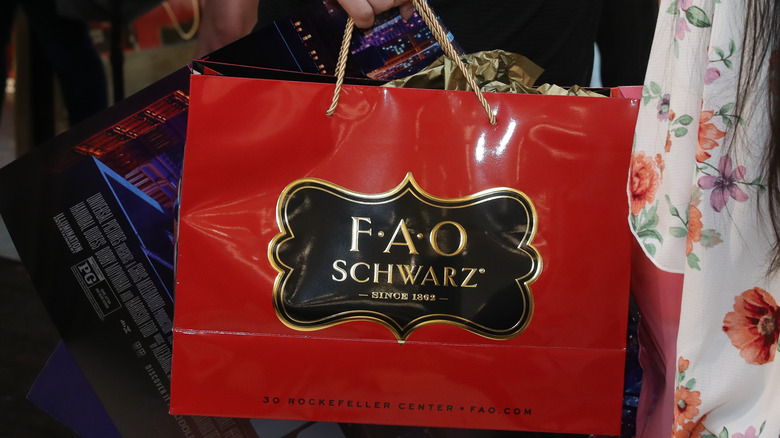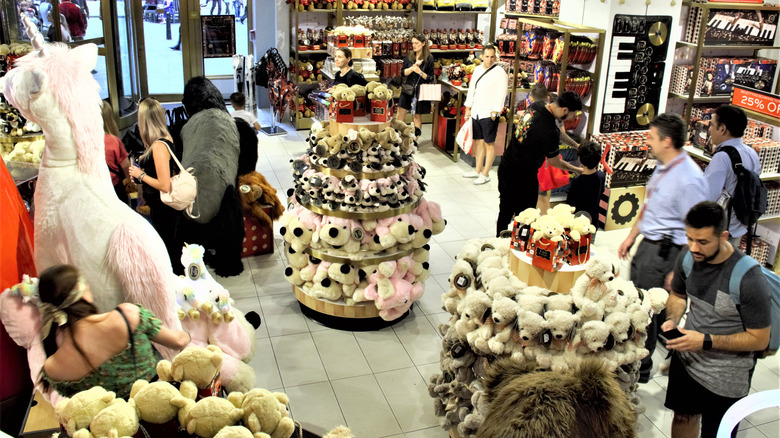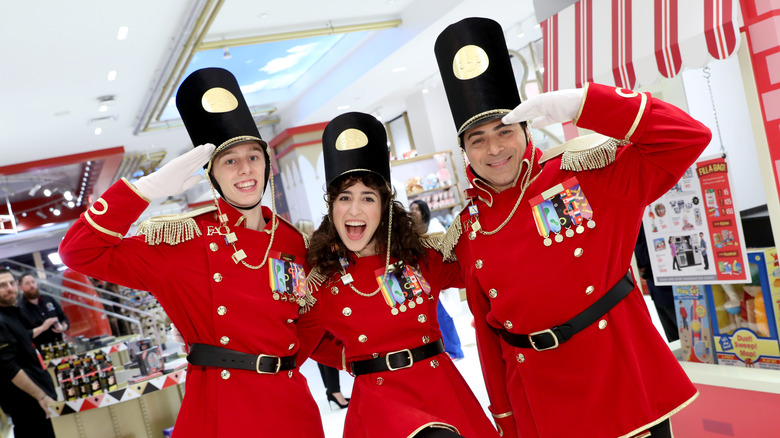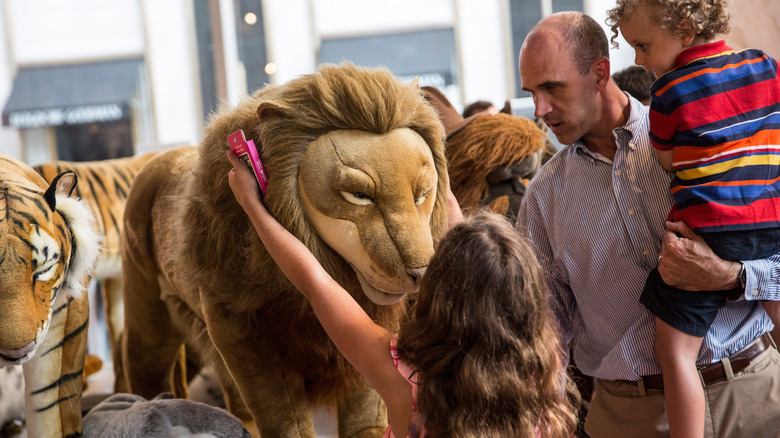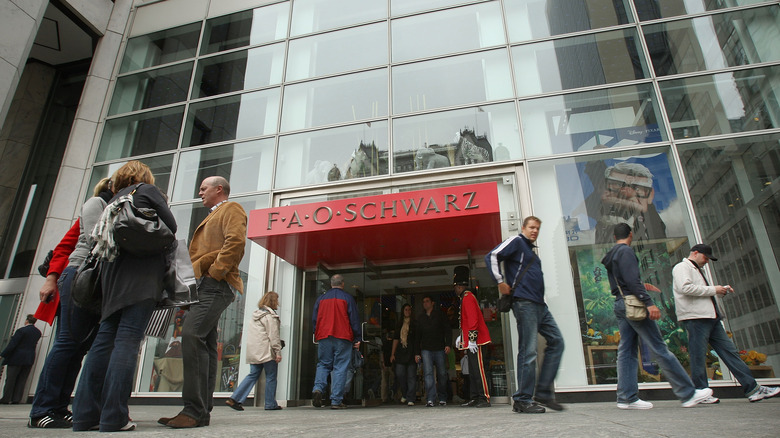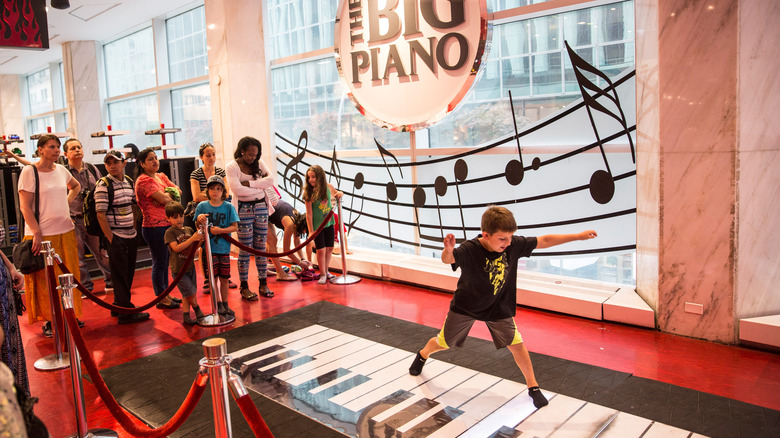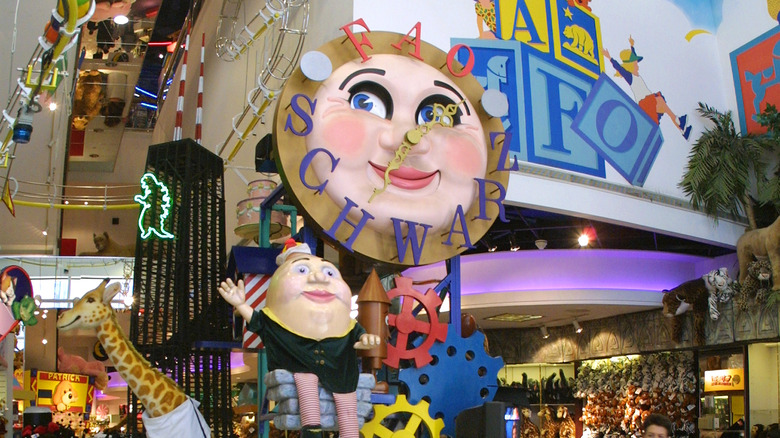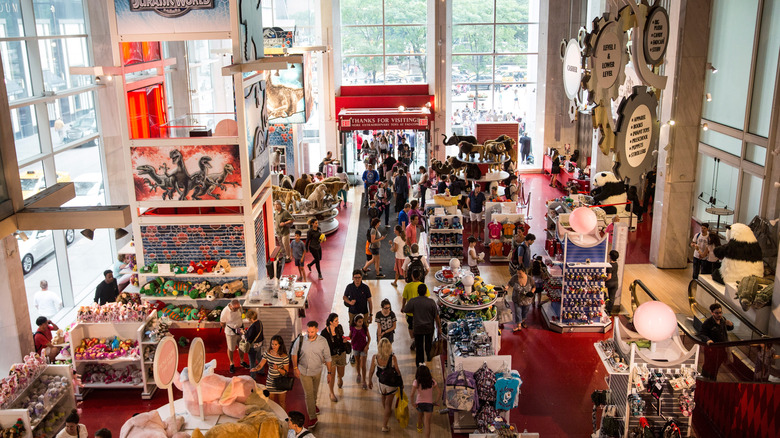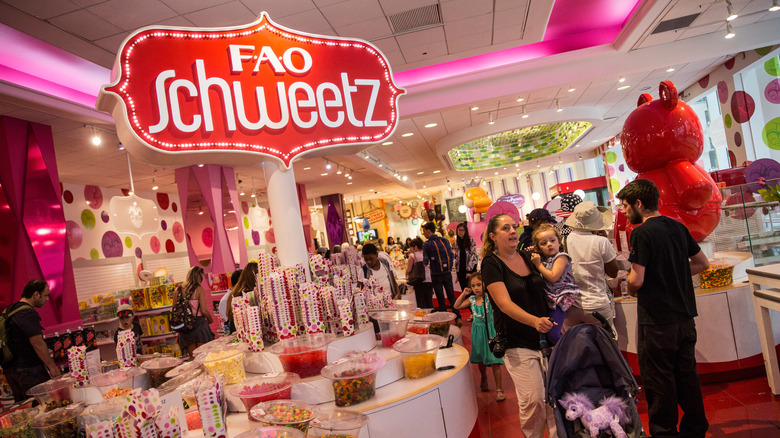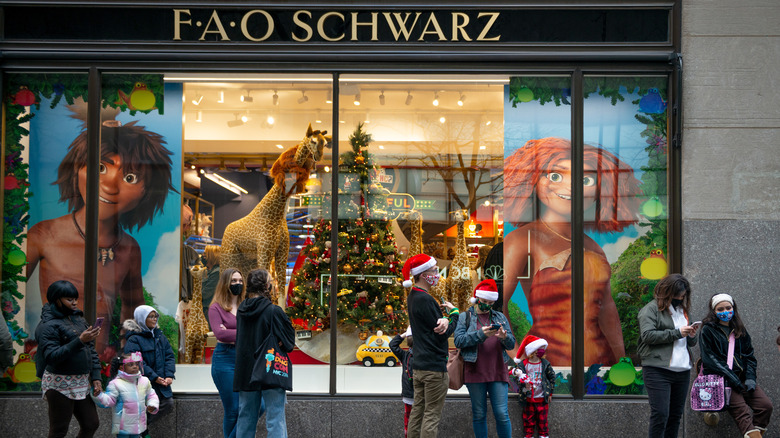History Of America's Oldest Toy Store
An indelible scene of Americana is one of red-cheeked children exhaling steamy breath as they stare through a toy store window to a fantasy world of dolls, robots, trains, and gadgets. It is a holiday meme worthy of Norman Rockwell, who in fact painted the subject in several canvases. Yet this worthy piece of joyous (yet avaricious) holiday culture would not have been possible without that most famous of toy emporiums, FAO Schwarz.
According to Town and Country Magazine, FAO Schwarz is America's oldest toy store. Yet its age is secondary to its importance. FAO Schwarz introduced marketing techniques that helped lubricate the crossover between culture and commercial. For example, Santa Claus mall appearances are thanks to FAO Schwarz. It also gained a reputation of being the most wondrous and expensive toy store in the world. Yet the story of this fabled store is complex. Let's discover the fascinating history of America's oldest toy store.
It was originally in Baltimore
Virtually anyone who knows anything about FAO Schwarz will immediately associate it with high end Manhattan retail. However, as told by "Toys and American Culture: An Encyclopedia," the story began in Baltimore. Four German immigrant brothers, Henry, Gustav, Frederick, and Richard lived there in the mid-19th century. According to "Christmas in New York," they were the sons of a Westphalian goldsmith who notably made a gold bathtub for Napoleon's brother.
The brothers decided to get into the retail business by opening a department store that specialized in stationary. However, in 1862, some of their German suppliers included toys in their shipments to try to generate interest in new products. The brothers quickly found that the toys were more popular than the stationary. Following the money, Henry established a toy store called Schwarz Toy Bazaar.
The brothers decided to branch out to multiple cities in 1870. Frederick Augustus Otto Schwarz packed up his toys and moved to New York to set up his own Schwarz Toy Bazaar, which according to "The Cyclopedia of American Biography," was located on Lower Broadway. By 1889, Frederick had truly struck out on his own by changing the name of his store to FAO Schwarz (via "SAGE Encyclopedia of Economics and Society").
FAO Schwarz was put on the map through its displays
The German toys that the Schwarz brothers imported to their emporiums were a hit because of their quality. Yet the products didn't just sell themselves. The Schwarzes had a genius for merchandising. As described by the "SAGE Encyclopedia of Economics and Society," they made their bazaars a "sensory experience." This included the immediate draw of well-appointed show windows that displayed the latest and most compelling toys available.
The stores were also a form of entertainment in themselves. "Toys and American Culture: An Encyclopedia" tells us that some Schwarz Toys Bazaars included rides, shooting galleries, and mechanical displays. The stores, sometimes more than the merchandise, were the real attraction.
If you were too far from a physical store to visit, there was also the option of ordering through the company's mail order catalog. This catalog became one of the most popular means to obtain the mid-to-high end toys the Schwarzes sold. So wildly successful was their approach that by 1876, they had become the largest toy retail company not just in America, but in the world.
It brought America the mall Santa
The crying baby on Santa's lap is really thanks to Frederick Schwarz. While the toy seller did not invent Saint Nick, FAO Schwarz certainly augmented his commercialization. In 1875, as reported by "Kids' Stuff," Santa began to appear at the store. As explained by "The Cute and the Cool," Father Christmas was relegated to a "grotto," where instead of letting children sit on his lap he hawked the mounds of toys about him. One 1876 advertisement proclaimed that FAO Schwarz's store at 765 Broadway was "Santa Claus Headquarters." Santa's explosion onto the retail scene in the big city department stores would not start until the 1890s, but his presence in FAO Schwarz was a harbinger of the Christmas shopping spectacle to come. FAO Schwarz brought us the mall Santa.
The press recognized Frederick Schwarz's achievement. "The Cyclopedia of American Biography" quotes the New York Sun calling him a master "Spielmann" and that his shop was unparalleled: "To stand outside and gloat over its window display was like peering into a telescope which gave hints of wondrous worlds which could be explored by going through the narrow doorway of the magician's palace... No toyshop of Nuremberg, no witch's hut, no palace of Aladdin even, was more definitely fixed in the minds of children of all ages than this actual toyshop..."
FAO Schwarz became known for value
By the late 19th century, FAO Schwarz had earned a reputation as a purveyor of high quality toys. "Toys and American Culture: An Encyclopedia" tells us that the store became a favorite haunt of the elite and a must-visit destination. Much of this was because of how unique its toys were. Imported from Europe, they stood apart from anything else available in a department store.
FAO Schwarz has since earned a reputation for being outrageously expensive. This is somewhat unfair. In recent years, certain toys have been priced in the thousands of dollars, but early on the store was said to offer value. A January 1, 1876 article from the New York Times describes Schwarz's store as having "an exhibition of toys, dolls, games, and fancy articles, comprising the very latest novelties in that line, which he sells at very low prices." The reason given by the Times is that Schwarz bought his items in bulk with cash down, which allowed him to keep prices low.
At the same time, FAO Schwarz was not comparable to later discount toy stores. Town and Country Magazine quotes Caroline Schwarz-Schastny, a descendent of Frederick Schwarz as saying, "There was much more interest in actually selling, in listening to what people wanted and making suggestions, more interest in what people wanted and needed."
It moved many times
FAO Schwarz's original New York location was on Broadway. However, in the course of its history it moved frequently. This seems to be because Frederick Schwarz was interested in relocating the store to more upscale, central shopping districts. Thus, as New York City's uptown became more elite, the store moved to where his presumed clientele would be.
"The Cyclopedia of American Biography" traces the early history of the store. In 1879, it moved to 14th Street at Union Square where, as explained by "Toys and American Culture," it sat next to the upscale Tiffany & Co. Then, in 1897, it took over an entire seven-floor building on West 23rd Street. Then, in 1911, right before Schwarz's death, it moved up to 5th Avenue at 31st Street into a yet larger quarters. During this time FAO Schwarz cemented its reputation for serving New York's well-to-do children. Town and Country Magazine recounts how the children of Theodore Roosevelt and the child actor Jackie Coogan both purveyed the store. In fact, Roosevelt would reportedly let his kids fill up wicker baskets with toys. In 1931, the store moved once again. As explained in "The Encyclopedia of New York City," it set its roots at 745 Fifth Avenue at 58th Street and would remain there for over five decades.
FAO Schwarz remained in family hands for many decades
While Frederick Schwarz died in 1911, the Schwarz family maintained a hand in the business. As reported by the New York Times, the business fell into the hands of his son, Henry. For several decades, the store was completely a family affair, directly or indirectly. "The Encyclopedia of American Biography" explains that even though some of Schwarz's children may have broken out into other fields — his son Herbert Schwarz was an editor for the Museum of Natural History's magazine — some simultaneously remained directors of the company.
These family ties certainly made the business flourish. FAO Schwarz expanded to seven locations, including Boston and Palm Beach. It was only in the 1960s that the company named a president who was not in the Schwarz bloodline. By this point, there was a worry about diversifying the company's portfolio since it made almost all of its approximately $6 million in annual sales in the last two months of the year.
It was first bought out by a parent magazine outfit
By the 1960s, FAO Schwarz began its history as a corporate asset. The first move occurred in 1963 when, as reported by the New York Times, the business was purchased by Parents' Magazine Enterprises, which was chaired by George J. Hecht. He aimed to expand Schwarz's reach, promising "to have Schwarz stores all over the United States."
Two Schwarz family members remained on the board of directors, but the family essentially lost control of the business. Yet they didn't lose control of the name. Town and Country Magazine recounts how as part of the deal, the Schwarzes licensed the name to the new owner for five years and that they earned a royalty on sales. Yet when the five years had elapsed, the FAO Schwarz brand was still so powerful that it was unthinkable to change the store's name. The new owners renewed the licensing agreement and then later bought it outright. So FAO Schwarz remained FAO Schwarz, but mainly without Schwarzes. The family instead took the royalties to begin a family foundation to train young people for leadership roles.
FAO Schwarz was traded like baseball cards
Parents' Magazine Enterprises did not hold onto FAO Schwarz for long. As noted by Town and Country Magazine, in 1970, WR Grace bought the business. Then in 1974, the New York Times reported the store's sale to the Franz Carl Weber Holding Company of Zurich, Switzerland for $3 million in cash in exchange for 91.7% control of the company. The Schwarzes held the rest.
WR Grace gave up on FAO Schwarz mainly because it didn't fit into their mass market models. A spokesperson stated, "It doesn't fit into our current business mix. We have several toy wholesaling and retailing concerns; but they are geared toward mass merchandising. Schwarz is a specialty toy chain with many imports."
Weber held onto the toy store for longer, but there was retrenchment. The business had already seen several management shake ups, plus it was under pressure from new trends in toy retail which emphasized discount selling at large toy retailers such as Toys "R" Us. As a result, Weber closed 10 FAO Schwarz's locations by 1985, leaving 22 stores remaining. That year, ownership returned to the United States with a purchase from California-based Christiana Companies, which specialized in real estate development. The sale reportedly had to do with infighting between the remnants of the Schwarz family and Weber.
It got a reboot in the mid-1980s
Christiana Companies quickly sold the business to investors Peter C. Morse and Peter Harris in 1986 (via the New York Times). The 41-year-old Harris then became president and CEO. By then, the future of the venerable toy store was in doubt. New York Magazine quoted the chairman of Hasbro at the time as stating, "With each sale the store lost step. The quality of the displays, the cleanliness, the lighting slipped; the windows were mediocre; the pricing outrageous."
Harris hoped to change this, and in 1986 he moved FAO Schwarz from its decades-old location to a larger quarters in the GM building across the street. These premises, at 40,000 square feet, provided space for more over-the-top displays including a 25-foot tall clock. This did not sit well with some long-time New Yorkers who had only known FAO Schwarz at its old Fifth Avenue location, perhaps not realizing that the store had in fact moved multiple times in its early history.
The Fifth Avenue store was FAO Schwarz's most famous location
FAO Schwarz at 58th Street and Fifth Avenue was the location that is the most fondly remembered today. Peter Harris sought to make the location striking. As described by "Toys and American Culture," the entrance was guarded by two toy soldiers and an immense teddy bear. To feed children's fantasies further, the new site had a Lego city, ice cream parlor, and a cafe.
Town and Country Magazine reports that Michael Jackson and Diana Ross were both regulars at the flagship store, being hustled into a special VIP room. Yet the scene that has memorialized FAO Schwarz more than any other was shown here in the 1988 film, "Big," starring Tom Hanks. In the film, Hanks plays a child who is magically transformed into an adult. During the course of the film, he and an executive for a toy company he lands a job with walk through FAO Schwarz. Then they encounter a 22-foot floor piano on which they play a duet of "Heart and Soul" and "Chopsticks."
FAO Schwarz faced headwinds in the 1990s
Peter Harris had done a remarkable job in restoring and even enhancing the FAO Schwarz brand. This enabled him and Peter C. Morse to sell the business to Royal Vendex in 1990. This new owner, according to Town and Country Magazine, was a Dutch concern that looked to expand the FAO Schwarz empire. Yet not all was well in toy land.
In competition with major discounters such as Walmart, FAO Schwarz struggled. In 2001, the Washington Post interviewed Kurt Barnard, president of the Barnard Retail Trend Report, who stated, "FAO Schwarz is an anachronism because most of the toys available there are available elsewhere at lower prices." This was, as explained by the New York Times, exacerbated by the September 11, 2001 terrorist attacks, which forced the store to close for a week. The event resulted in a 22% drop in sales for that quarter.
In November of that year, Royal Vendex sold most of the business to the toy company Right Start for $58.3 million in stock. Right Start seemed to have the chops for the job – Slate reports that it brought the toy business Zany Brainy out of bankruptcy.
FAO Schwarz went bankrupt twice
Right Start renamed its company FAO, Inc, perhaps hoping to imbibe the benefits of the established brand. However, as reported by Slate, the post-9/11 recession fell upon FAO Schwarz like a toddler smashing a Lego skyscraper. In 2003, the company collapsed, and that January it filed for bankruptcy.
Things seemed to have been righted after the company closed dozens of locations and made a deal to open FAO Schwarz boutiques in Saks department stores. Yet it didn't work, resulting in a second bankruptcy filing in December 2003. The company liquidated Zany Brainy, its Right Start stores, and started dissolving FAO Schwarz. According to Town and Country Magazine, the flagship location was shuttered in January 2004.
All seemed lost for the venerable toy icon, but the investment company DE Shaw & Co. paid $41 million for the flagship store and a branch in Las Vegas plus $10 million in debt. The New York store reopened on Thanksgiving Day. There seemed to be some improvement. As the author of the Slate article wrote, "FAO in New York certainly seems like a much happier and fresher place that the last time I went: lighter and less claustrophobic." It looked like the business was on the right track again. Tourists came back, and the flagship store won a Lumen award for innovative lighting. Yet while FAO Schwarz did survive, it never managed to become a money maker.
Toys "R" Us killed FAO Schwarz's flagship location
It is unsurprising given FAO Schwarz's history that the enterprise was bought once again in 2009, for an unspecified amount. This time it was by Toys "R" Us. Gerald L. Storch, Toys "R" Us' chief executive officer, was quoted by the New York Times as saying, "At its core this is about one of the world's greatest brands. It's a store that's steeped in tradition as well as popular culture."
Toys "R" Us attempted to capitalize on the brand by integrating FAO Schwarz sections to its ubiquitous big-box toy stores. The company elicited criticism for this act with one branding executive commenting, "It's big-box retail selling F.A.O. Schwarz as big-box product. It feels a little lacking in joy."
For its part, Toys "R" Us defended the seemingly soulless move by saying that it was the only way to keep the brand going. While prices at FAO Schwarz were still unconscionably high — one example being a Barbie foosball table selling for $25,000 — the items found at the Toys "R" Us stores would be priced to sell. Toys "R" Us even revamped the traditional logo of the store from what had been a toy soldier, rocking horse, and wooden blocks to a jester nicknamed Wit. However, these efforts did not work. In 2015, Toys "R" Us closed the New York store down. USA Today reported that the company was looking for a new location with lower rent.
FAO Schwarz's brand is too powerful to keep down
Toys "R" Us never found a new location for FAO Schwarz. Instead, as Business Wire reported, it sold the business to ThreeSixty Group for an undisclosed amount in 2016. This new owner (we are up to 10 since the Schwarzes sold out) designed and distributed consumer goods, which included toys. Kirk McLean, a cofounder of the group stated, "We are investing heavily in this brand and believe there is a tremendous opportunity to build upon the heritage experience and nostalgia of FAO Schwarz." (via Business Wire).
This time, the focus was to return the business to its roots and focus on unique products. This won some support from the descendents of the Schwarzes and the company reopened a new FAO Schwarz at Rockefeller Center. Business Insider reported that the 20,000-square-foot space was replete with plush animals and of course the walk-on floor piano.
Since then, it seems that the toy store is once again undergoing an expansion. Chain Storage Age reported that ThreeSixty built new airport stores in New York and Chicago. Forbes reported that FAO Schwarz expanded internationally, opening flagships in Beijing, London, and Dublin. The latest store to open per PR Newswire is in Milan, Italy in 2021. The intent seems to be to build up the brand as international and upscale. It may just work and allow this enduring icon to live on.
